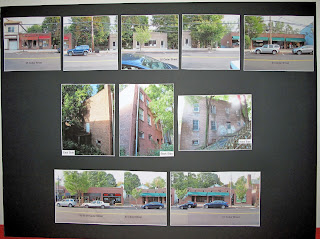It's been too long since I posted anything on the building because I've been busy responding to Hurricane Sandy's aftermath. Fortunately the building was spared damages and we came out safe and sound in our Brooklyn apartment.
We are so close to closing on the 203(k) loan. It's just a matter of days to weeks (cross my fingers) as we wait for the contractor's information.
In the meantime, here's a little history on the building that I've been unearthing.
The building had been the W.T. Barnes Upholstery business for several decades. The previous owner worked at the store since high school, and by the time we bought it, she was ready to retire.
When we were at the Dobbs Ferry Festa about a couple months ago, we met a woman named Nancy Delmerico who told us that her father used to work at the building when it was the Water Company. Nancy had a picture of her father, Patrick Delmerico, standing in front of the building (on the left) that was published in a local newspaper dated January 7, 1938.
.JPG) |
| Picture courtesy of Nancy Delmerico |
Eager to find out more, I called the New Rochelle Water Company but did not get a call back. Next I tried the Dobbs Ferry Historical Society, which had provided Rick with some information on the building several months ago. In particular, Mary Donovan at the historical society, provided us with an excerpt from a book called Life of a River Village, Dobbs Ferry: a Centennial Publication.
"The left-hand side of Cedar Street, backed by the deep ravine, had a few small buildings...The building now occupied by Barnes Upholsterers belonged to W.G. Brown. In 1911 it was to become the home of the Telephone Company, which outgrew its original office in the rear of Herbeck's Drug Store on Main Street."
 |
| Page from Life of a River Village |
The historical society pointed me to the website: http://fultonhistory.com/Fulton.html, which has information from early Dobbs Ferry newspapers.
Searching for the address, I came across several references to the building that didn't seem to make sense; there were interesting advertisements that stated the building was a theater, a music & radio shop, and republican presidential challenger to FDR (Wendell Wilkie). However, there's a theater across the street, so at least some of the listings didn't make sense there.
I asked the historical society about this. Mary Donovan mentioned the street must have been renumbered. She mentioned that there is a vague reference to renumbering in her records, but no detailed information is available.
As we continue this we may be able to put together a better timeline and have a more thorough history of the life of the building.
Thanks to both Nancy Delmerico and Mary Donovan for historical information!















































